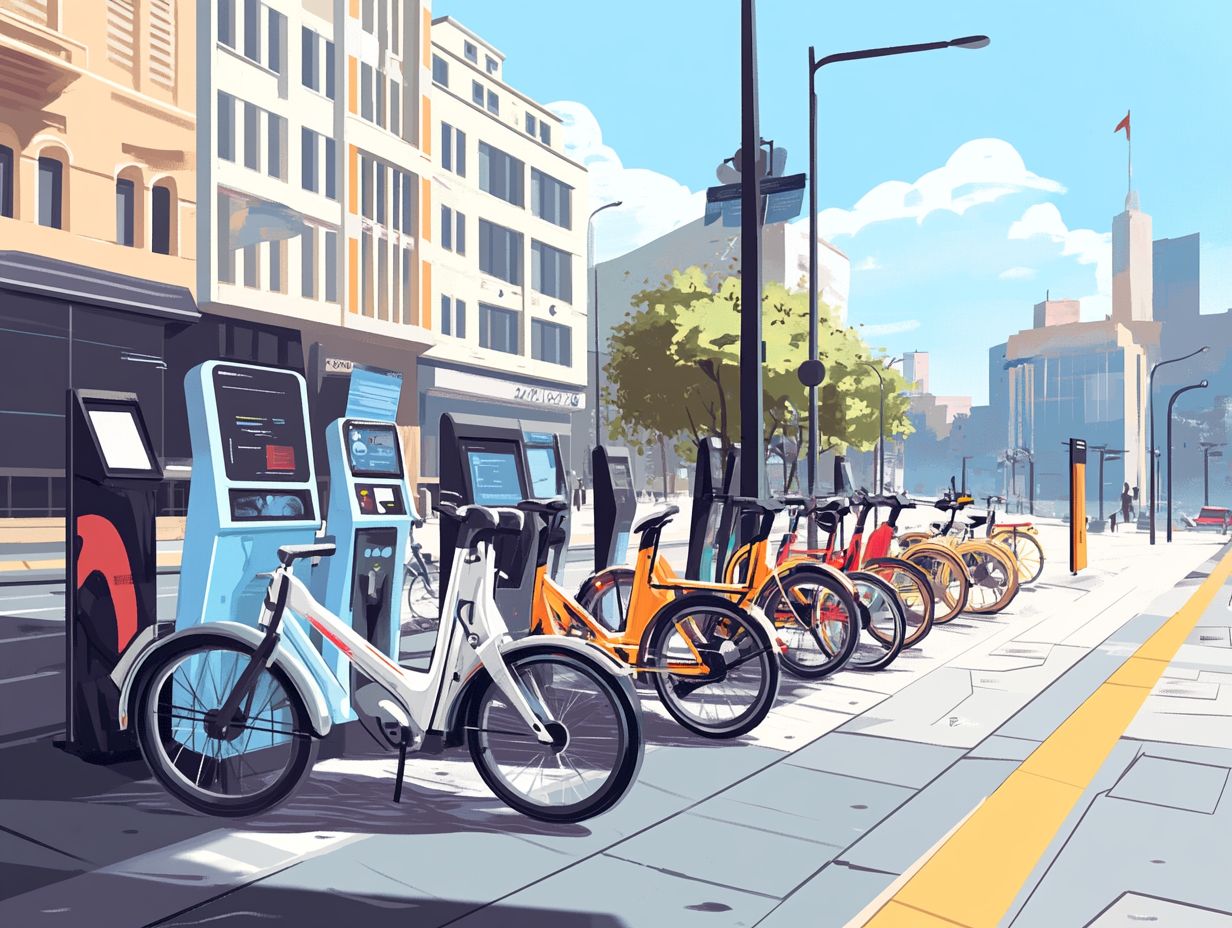Electric Bicycle Sharing Laws in Major Cities
Electric bicycle sharing programs have swiftly become essential in urban landscapes. They are reshaping our perception of transportation. As cities increasingly adopt these eco-friendly alternatives, understanding the relevant laws and regulations is important.
This article delves into the intricate web of electric bicycle sharing laws, addressing safety concerns and environmental impacts. You ll discover how these regulations differ from one city to another, their economic ramifications, and ways you can actively participate in shaping the future of urban mobility. Join us as we explore this exciting change in how we get around!
Contents
- Key Takeaways:
- 1. What Are Electric Bicycle Sharing Programs?
- 2. Why Are Electric Bicycle Sharing Programs Popular?
- 3. What Are the Laws and Regulations Surrounding Electric Bicycle Sharing?
- 4. How Do These Laws Differ in Different Cities?
- 5. What Are the Benefits of Electric Bicycle Sharing Laws?
- 6. What Are the Challenges of Implementing Electric Bicycle Sharing Laws?
- 7. How Do Electric Bicycle Sharing Laws Affect the Environment?
- 8. How Do Electric Bicycle Sharing Laws Impact Traffic and Transportation?
- 9. What Are the Safety Concerns Related to Electric Bicycle Sharing?
- 10. How Do Electric Bicycle Sharing Laws Address Privacy Concerns?
- 11. What Are the Economic Impacts of Electric Bicycle Sharing Laws?
- 12. How Do Electric Bicycle Sharing Laws Address Equity and Accessibility?
- 13. What Are the Future Predictions for Electric Bicycle Sharing Laws?
- 14. How Can Individuals and Communities Get Involved in Electric Bicycle Sharing Laws?
- 15. What Can We Learn from Other Countries’ Electric Bicycle Sharing Laws?
- Frequently Asked Questions
- 1. What are electric bicycle sharing laws in major cities?
- 2. Are electric bicycles allowed on city sidewalks?
- 3. Do I need a license to ride an electric bicycle in major cities?
- 4. Are there age restrictions for using electric bicycle sharing programs in major cities?
- 5. Are helmets required when riding an electric bicycle in major cities?
- 6. Are there designated areas for parking electric bicycles in major cities?
Key Takeaways:

- Electric bicycle sharing programs are gaining popularity in major cities due to their convenience and sustainability benefits.
- Electric bicycle sharing laws and regulations vary in different cities, but generally aim to promote safety, environmental protection, and accessibility.
- These laws can improve traffic and transportation, address equity and accessibility issues, and contribute to a cleaner and more sustainable environment.
1. What Are Electric Bicycle Sharing Programs?
Electric Bicycle Sharing Programs, commonly known as e-bike sharing services, offer a cutting-edge approach to urban transportation. They provide you with convenient access to electric bikes, easily bringing eco-friendly travel options to your area. This not only promotes public health but also aligns with local rules about how to use them.
These programs typically function through a network of e-bike stations and bike lanes strategically positioned throughout the city. E-bike apps help you find and rent bikes easily, ensuring a smooth and user-friendly experience. It’s also important to be aware of the electric bicycle age restrictions by state to ensure compliance while enjoying your ride.
Cities like San Francisco and New York have successfully rolled out e-bike stations, making them an appealing option for both short commutes and leisurely rides. By incorporating these services into existing infrastructure, you’re not only helping to alleviate traffic congestion but also fostering eco-friendly commuting habits.
Local governments play a crucial role in funding these initiatives and developing bike lanes, ensuring both safety and accessibility. This teamwork fosters a healthier lifestyle for all city dwellers.
2. Why Are Electric Bicycle Sharing Programs Popular?
Electric Bicycle Sharing Programs have rapidly gained traction, offering you convenient riding options that cater perfectly to those in search of biking alternatives for daily commutes. These programs not only highlight the health benefits of cycling but also help cultivate a vibrant biking community.
By encouraging more individuals to abandon motorized transport, these initiatives promote a healthier lifestyle, making biking accessible to a broader audience. You ll find that many participants report improved fitness levels and overall well-being, which certainly contributes to the surge in popularity. With growing awareness about carbon footprints, e-bikes present an eco-friendly choice that actively helps reduce urban congestion and pollution.
Recent statistics reveal that cities with e-bike sharing programs have seen a remarkable uptick in usage, with some areas experiencing a staggering 400% growth in just a few years. This shift in transportation preferences is not just a trend; it’s a movement supported by enthusiastic community feedback. As more delivery riders embrace this change, understanding electric bicycle regulations for delivery riders becomes crucial.
3. What Are the Laws and Regulations Surrounding Electric Bicycle Sharing?
The laws and regulations surrounding Electric Bicycle Sharing Programs are essential for ensuring safety, defining vehicle classification, and establishing the operational framework that local governments use to manage e-bike rentals and public usage effectively.
These regulations often reference federal guidelines that categorize electric bikes into specific classes, based primarily on their maximum speed, which refers to how fast the bike can go, and power levels, which indicates how much energy the bike uses. For a deeper understanding of how these rules vary, you can explore electric bicycle laws: a comparison between states. Local governments have a crucial role in this ecosystem, setting additional rules that cover parking, access to bike lanes, and age requirements for riders.
Community engagement is vital in this process, as residents can offer invaluable insights on the safety measures needed for a seamless coexistence between bicycles and other modes of transportation. With the rising popularity of e-bikes, it s imperative that these programs integrate effective safety protocols to safeguard both riders and pedestrians.
4. How Do These Laws Differ in Different Cities?
The laws governing Electric Bicycle Sharing Programs vary significantly across cities, shaped by local policies, urban planning considerations, and the unique needs of each community. This results in a diverse landscape of biking laws and regulations that affect your riding experience.
Take Amsterdam, for example; the city exemplifies a comprehensive approach to integrating electric bikes, complete with extensive bike lanes and parking facilities that reflect its rich cycling culture. On the flip side, you might find other cities struggling with poor infrastructure, making it difficult to implement effective programs. Community feedback is crucial in these scenarios, as residents often advocate for safer bike paths or more charging stations.
Urban mobility discussions frequently encounter unique challenges such as traffic congestion and safety issues like accident risks, along with funding limitations. Successful initiatives in cities like San Francisco show how legislative support can harness community input to cultivate vibrant electric bike ecosystems, promoting sustainable transportation alternatives for everyone.
5. What Are the Benefits of Electric Bicycle Sharing Laws?

Electric Bicycle Sharing Laws present a range of remarkable benefits that you can truly capitalize on. By encouraging increased physical activity, these laws can enhance your health while also boosting local economies.
They also support environmental sustainability by providing biking alternatives that effectively reduce traffic congestion and lessen reliance on motor vehicles.
Not only do these laws promote a shift towards eco-friendly transportation, but they also create job opportunities in bike maintenance and distribution, putting people to work in an innovative industry. In cities like Paris and San Francisco, where e-bike sharing has taken off, studies show a remarkable 30% drop in carbon emissions, significantly advancing municipal sustainability goals. To stay informed about the regulations, it’s important to understand navigating electric bicycle licensing requirements.
Take Seattle as an example; a report highlighted that e-bike sharing programs boosted local retail sales by 20% within just a year. This proves that these initiatives can actively boost your local economy!
The health benefits are equally compelling, with regular e-bike users reporting a 25% drop in obesity rates according to a community survey, underlining the multifaceted advantages of adopting e-bike sharing legislation.
6. What Are the Challenges of Implementing Electric Bicycle Sharing Laws?
Implementing Electric Bicycle Sharing Laws presents exciting challenges that require your attention! These include tackling safety issues to ensure everyone feels secure while biking, ensuring smooth integration within the community, and adapting local infrastructure to accommodate the rise in e-bike usage all while avoiding traffic congestion and noise pollution.
To tackle these hurdles effectively, you ll want to adopt a multifaceted approach that puts user safety front and center. This means improving bike lanes and signage, as well as fostering community acceptance by actively seeking local feedback during the planning stages.
Collaboration with transportation experts will be essential for developing infrastructure that prioritizes e-bikes. This could help ease road congestion and enhance overall transit options. Don’t overlook the importance of community outreach initiatives, educational programs, and pilot projects. These efforts can be instrumental in showcasing the benefits of e-bike sharing, paving the way for a smoother transition toward a more sustainable and bike-friendly environment.
7. How Do Electric Bicycle Sharing Laws Affect the Environment?
Electric Bicycle Sharing Laws have a profound impact on the environment by encouraging sustainable transportation alternatives. This shift can help reduce traffic congestion and lower carbon emissions.
Additionally, it enhances access to public parks and green spaces for you and your community.
When cities adopt e-bike sharing initiatives, they help reduce reliance on fossil fuels and contribute to cleaner air quality. With fewer traditional vehicles on the road, overall emissions decrease, positively affecting the health and well-being of urban populations like yours. To ensure safe riding, it’s important to be aware of electric bicycle lane laws and local ordinances.
These laws also inspire the development of improved cycling infrastructure, creating a more attractive and efficient urban landscape for everyone. As you and your fellow residents opt for e-bike rides instead of car trips, you engage in more eco-friendly commuting practices, paving the way for greener cities and fostering richer interactions with nature in your surroundings. To better understand the regulations that apply, it’s important to explore the state-specific electric bicycle legal frameworks that govern e-bike use in your area.
8. How Do Electric Bicycle Sharing Laws Impact Traffic and Transportation?
Electric Bicycle Sharing Laws significantly influence traffic and transportation dynamics, offering you convenient riding options that can ease traffic congestion, enhance urban mobility, and encourage the development of dedicated biking routes that benefit the entire community.
The integration of e-bikes plays an important part in improving public health and promoting biking alternatives.
By integrating e-bike sharing into your local transit ecosystem, you’ll notice a shift in how residents navigate urban landscapes. This transition reduces reliance on traditional vehicles and transforms public transportation systems, adapting to the rising demand for seamless connections between bike-sharing stations and transit hubs. To understand the electric bicycle regulations in urban areas, ultimately enhancing the overall riding experience.
Local policymakers are now prioritizing the creation of safe bike lanes and proper storage facilities, fostering a more bike-friendly culture for you and your neighbors. As municipalities invest in this essential infrastructure, urban planners must consider the growing popularity of cycling, along with the needs for economic development and environmental impact, leading to more sustainable and efficient transportation solutions for everyone.
9. What Are the Safety Concerns Related to Electric Bicycle Sharing?
Safety concerns surrounding Electric Bicycle Sharing Programs are crucial, emphasizing the need for effective safety measures, a responsible biking culture, and the protection of youth in community areas where e-bikes are commonly used.
These concerns become even more pressing with the rise in accidents often linked to inexperience with electric bikes, especially among new riders. It s essential for you as a user to be educated on proper usage, which includes the importance of wearing helmets, adhering to traffic rules, and understanding electric bike regulations to ensure safety.
The call for improved infrastructure cannot be overstated; safe bike lanes and clearly marked crossings can drastically reduce the risk of collisions, reinforcing the importance of local government support in these initiatives.
Successful initiatives, like community workshops and local partnerships, showcase effective strategies for engaging riders in safety practices and nurturing a sense of responsibility. This ultimately fosters a safer environment for everyone involved while promoting public opinion and community feedback.
10. How Do Electric Bicycle Sharing Laws Address Privacy Concerns?

Electric Bicycle Sharing Laws must consider privacy concerns, especially regarding data collection. This means gathering information about how you use the bikes and how government software tracks e-bike rentals and user patterns. It’s crucial to ensure that there are transparent practices to uphold community trust.
This leads to discussions about the environmental sustainability and long-term impacts of e-bike sharing programs. It’s essential to implement strong ways to keep your data safe and ensure your personal information is secure and used only for relevant purposes.
Regulations should include feedback mechanisms. This gives you, the resident, a voice in how your data is managed and shared, allowing for greater community engagement.
Engaging in open dialogues between local governments and e-bike operators can create a balance. This allows for efficient management of e-bike resources while respecting your individual privacy. Ultimately, addressing these concerns cultivates a safer environment, encouraging participation in e-bike sharing initiatives without the anxiety of unwarranted surveillance or data misuse.
11. What Are the Economic Impacts of Electric Bicycle Sharing Laws?
The economic impacts of Electric Bicycle Sharing Laws are significant. They pave the way for economic development by establishing bike-sharing services and attracting investments.
These initiatives also encourage local governments to support grant programs that enhance biking options in urban spaces and public parks. This can transform local economies don’t miss out!
By creating jobs in areas like maintenance and operations, cities like Barcelona and San Francisco showcase how e-bike sharing programs diversify transportation options.
These programs increase foot traffic to local businesses, fostering economic vitality and prompting investments in cycling infrastructure. This benefits the entire community and contributes to the overall environmental impact.
12. How Do Electric Bicycle Sharing Laws Address Equity and Accessibility?
Electric Bicycle Sharing Laws enhance equity and accessibility, promoting inclusivity in biking culture. These regulations ensure diverse community members have ample access to biking alternatives.
They also aim to improve local infrastructure to meet specific needs, including public health measures that support active lifestyles. It’s essential that underserved populations can participate in cycling initiatives.
Local governments should engage with communities to address unique needs effectively. By facilitating conversations and gathering feedback, officials can develop bike-sharing programs that genuinely resonate with local demographics.
This collaborative approach strengthens community ties and empowers individuals by providing essential transportation options for diverse needs.
Inclusive policies are pivotal in enhancing mobility and fostering a sense of belonging among all citizens. Ultimately, they make biking an appealing choice for everyone while supporting the broader goals of urban planning and transportation technology.
13. What Are the Future Predictions for Electric Bicycle Sharing Laws?
Future predictions for Electric Bicycle Sharing Laws indicate that you can expect a continued surge in e-bike popularity. This growth will be fueled by advancements in transportation technology and increasing legislative support.
Moreover, a vibrant biking community is eager to embrace sustainable urban mobility solutions that enhance overall community integration. As awareness of climate change deepens, it’s likely that cities will revise their infrastructure policies, making it easier for more people to ride bikes.
This change could lead to the creation of comprehensive bike lanes and dedicated e-bike zones. This signifies not just a transformation in laws but also a broader societal embrace of eco-friendly commuting, promoting community engagement and access to public parks. For more insights, check out electric bicycle regulations: a global overview.
Imagine the integration of smart technology, such as tracking bike availability instantly, which could simplify operations and elevate your riding experience. Urban planners must rethink road space allocation to ensure that the burgeoning e-bike sharing systems harmonize seamlessly with public transport and pedestrian pathways. Additionally, understanding the electric bicycle laws for commuters in New York is crucial for safe and compliant riding.
14. How Can Individuals and Communities Get Involved in Electric Bicycle Sharing Laws?
Join the movement! You can shape Electric Bicycle Sharing Laws by actively engaging in public opinion initiatives and participating in local government meetings.
Fostering a biking culture that prioritizes safety for young riders and environmental sustainability enhances community engagement. By attending city council sessions, you can voice your opinions about proposed policies that impact e-bike infrastructure.
Organizing community workshops focused on cycling education can significantly enhance awareness and support for sustainable transportation options. This effort draws in families and environmental advocates alike, promoting biking culture within the community.
Collaborating with local businesses to sponsor events, such as group rides or safety workshops, strengthens community ties. It showcases your collective commitment to creating safer biking environments and promoting accessibility improvement.
Together, these efforts amplify diverse voices, demonstrating to policymakers that there is substantial demand for laws that promote responsible e-bike use. For riders, understanding the top electric bicycle laws ensures that environmental sustainability is at the forefront of urban planning.
15. What Can We Learn from Other Countries’ Electric Bicycle Sharing Laws?

Learning from the Electric Bicycle Sharing Laws of other countries can offer you invaluable insights into effective practices, innovative solutions, and community feedback mechanisms. These elements enhance e-bike sharing programs and promote biking alternatives globally, benefiting public health initiatives.
By examining case studies from various regions, you’ll discover that tailoring regulations to local needs can significantly boost user adoption while ensuring safety and sustainability. Successful implementations often blend user-friendly technology, strategic partnerships with local businesses, and incentives that encourage residents to engage actively in biking culture.
These international experiences underscore the importance of community engagement in the policy-making process. They demonstrate how stakeholder feedback can shape more responsive and effective regulatory frameworks.
Ultimately, these lessons empower you and local governments to create a seamless and appealing e-bike sharing environment. This environment aligns with the values and preferences of your community while enhancing social responsibility.
Frequently Asked Questions
1. What are electric bicycle sharing laws in major cities?
Electric bicycle sharing laws are rules that help manage how shared electric bikes are used in cities. They are designed to keep riders safe while ensuring the community s needs are met.
2. Are electric bicycles allowed on city sidewalks?
Electric bike laws vary by city. Some cities ban e-bikes on sidewalks completely, while others allow them at low speeds. Always check local rules before riding.
3. Do I need a license to ride an electric bicycle in major cities?
Most major cities don t require a special license for electric bikes. However, some may need a permit or registration. Check your city s regulations to stay compliant.
4. Are there age restrictions for using electric bicycle sharing programs in major cities?
Age restrictions for e-bike sharing vary. Some cities require riders to be at least 18, while others allow younger riders with parental consent. Review your city s rules before using bike-sharing services.
5. Are helmets required when riding an electric bicycle in major cities?
Many major cities require helmets for electric bike riders. Wearing one keeps you safe while you enjoy your ride! Always have your helmet on, no matter what the law says.
6. Are there designated areas for parking electric bicycles in major cities?
Some cities have special e-bike parking stations, while others let you use regular bike racks. Follow the parking rules to avoid fines. Always park responsibly to support sustainable transportation.




